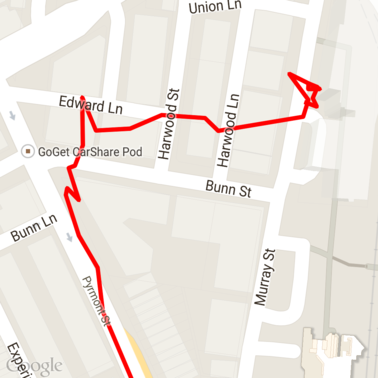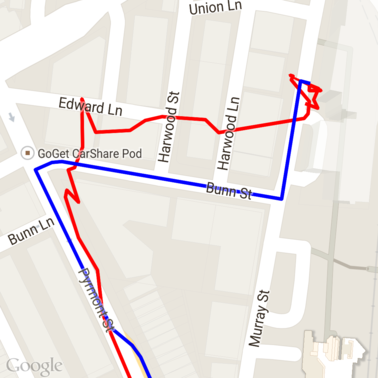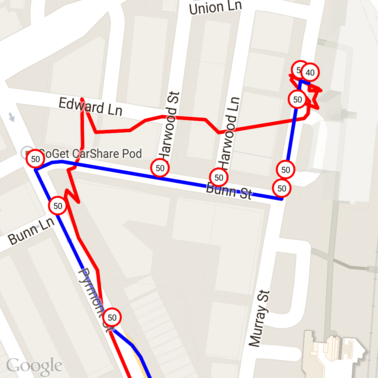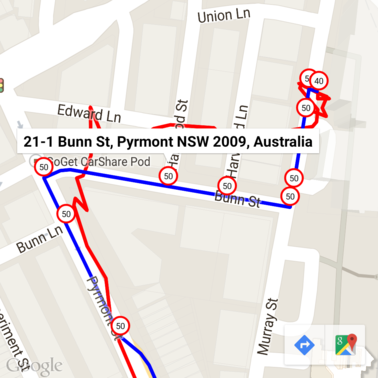获取数据
有多种方法可以获取收集到的位置数据。在这里,我们将介绍 用于获取数据的技巧,这些数据将与道路快照功能搭配使用 Roads API。
GPX
GPX 是一种基于开放式 XML 的格式,用于分享路线、轨迹和航点 由 GPS 设备捕获。本示例使用 XmlPull 解析器, 同时适用于 Java 服务器和移动环境的轻量级 XML 解析器。
/**
* Parses the waypoint (wpt tags) data into native objects from a GPX stream.
*/
private List<LatLng> loadGpxData(XmlPullParser parser, InputStream gpxIn)
throws XmlPullParserException, IOException {
// We use a List<> as we need subList for paging later
List<LatLng> latLngs = new ArrayList<>();
parser.setInput(gpxIn, null);
parser.nextTag();
while (parser.next() != XmlPullParser.END_DOCUMENT) {
if (parser.getEventType() != XmlPullParser.START_TAG) {
continue;
}
if (parser.getName().equals("wpt")) {
// Save the discovered latitude/longitude attributes in each <wpt>.
latLngs.add(new LatLng(
Double.valueOf(parser.getAttributeValue(null, "lat")),
Double.valueOf(parser.getAttributeValue(null, "lon"))));
}
// Otherwise, skip irrelevant data
}
return latLngs;
}
以下是一些加载到地图上的原始 GPX 数据。

Android 位置信息服务
从 Android 设备捕获 GPS 数据的最佳方式因您的 应用场景。观看有关接收位置信息的 Android 培训课程 更新以及 Google Play 位置示例 GitHub。
处理长路径
由于道路紧贴功能会根据完整路径推断位置, 处理长篇内容 路径(即超过 100 点/请求限制的路径)。
为了将各个请求视为一条长路径,您应该加入 存在一定程度的重叠,以至于将来自上一个请求的最终要点包括在内, 作为后续请求的第一个时间点要包含的数据点数量 取决于数据的准确性。您应添加更多积分 用于低准确度请求
此示例使用适用于 Google 地图服务的 Java 客户端发送分页请求和 然后,将数据(包括插值点)重新连接到返回的列表。
/**
* Snaps the points to their most likely position on roads using the Roads API.
*/
private List<SnappedPoint> snapToRoads(GeoApiContext context) throws Exception {
List<SnappedPoint> snappedPoints = new ArrayList<>();
int offset = 0;
while (offset < mCapturedLocations.size()) {
// Calculate which points to include in this request. We can't exceed the API's
// maximum and we want to ensure some overlap so the API can infer a good location for
// the first few points in each request.
if (offset > 0) {
offset -= PAGINATION_OVERLAP; // Rewind to include some previous points.
}
int lowerBound = offset;
int upperBound = Math.min(offset + PAGE_SIZE_LIMIT, mCapturedLocations.size());
// Get the data we need for this page.
LatLng[] page = mCapturedLocations
.subList(lowerBound, upperBound)
.toArray(new LatLng[upperBound - lowerBound]);
// Perform the request. Because we have interpolate=true, we will get extra data points
// between our originally requested path. To ensure we can concatenate these points, we
// only start adding once we've hit the first new point (that is, skip the overlap).
SnappedPoint[] points = RoadsApi.snapToRoads(context, true, page).await();
boolean passedOverlap = false;
for (SnappedPoint point : points) {
if (offset == 0 || point.originalIndex >= PAGINATION_OVERLAP - 1) {
passedOverlap = true;
}
if (passedOverlap) {
snappedPoints.add(point);
}
}
offset = upperBound;
}
return snappedPoints;
}
以下是运行道路吸附请求后由以上生成的数据。红色的 线是原始数据,蓝线是吸附数据。

配额高效利用
snap to Roads 请求的响应包含地点 ID 列表
这些点与您提供的点对应,如果您
设置interpolate=true。
为了高效利用您针对速度限制请求允许的配额, 您只应在请求中查询唯一的地点 ID。本示例使用 适用于 Google 地图服务的 Java 客户端,用于从地点列表查询速度限制 。
/**
* Retrieves speed limits for the previously-snapped points. This method is efficient in terms
* of quota usage as it will only query for unique places.
*
* Note: Speed limit data is only available for requests using an API key enabled for a
* Google Maps APIs Premium Plan license.
*/
private Map<String, SpeedLimit> getSpeedLimits(GeoApiContext context, List<SnappedPoint> points)
throws Exception {
Map<String, SpeedLimit> placeSpeeds = new HashMap<>();
// Pro tip: Save on quota by filtering to unique place IDs.
for (SnappedPoint point : points) {
placeSpeeds.put(point.placeId, null);
}
String[] uniquePlaceIds =
placeSpeeds.keySet().toArray(new String[placeSpeeds.keySet().size()]);
// Loop through the places, one page (API request) at a time.
for (int i = 0; i < uniquePlaceIds.length; i += PAGE_SIZE_LIMIT) {
String[] page = Arrays.copyOfRange(uniquePlaceIds, i,
Math.min(i + PAGE_SIZE_LIMIT, uniquePlaceIds.length));
// Execute!
SpeedLimit[] placeLimits = RoadsApi.speedLimits(context, page).await();
for (SpeedLimit sl : placeLimits) {
placeSpeeds.put(sl.placeId, sl);
}
}
return placeSpeeds;
}
以下是由以上示例生成的数据,在每个唯一地点 ID 处都标记了速度限制。

与其他 API 交互
在贴靠道路中返回地点 ID 的好处之一 您可以在多个 Google Maps Platform API。此示例使用适用于 Google 地图服务的 Java 客户端 ,以便对从上述道路吸附请求返回的地点进行地理编码。
/**
* Geocodes a snapped point using the place ID.
*/
private GeocodingResult geocodeSnappedPoint(GeoApiContext context, SnappedPoint point) throws Exception {
GeocodingResult[] results = GeocodingApi.newRequest(context)
.place(point.placeId)
.await();
if (results.length > 0) {
return results[0];
}
return null;
}
在该示例中,限速标记使用 Geocoding API。

示例代码
注意事项
支持本文的代码作为单个 Android 应用 仅作说明之用。在实践中,您不应将服务器端 API 密钥,因为无法保护密钥免遭未经授权的访问 通过第三方访问。相反,为了保障密钥的安全,您应该将 作为服务器端代理的面向 API 的代码,让您的 Android 应用发送请求 确保请求获得授权
下载
从 GitHub 下载代码。

